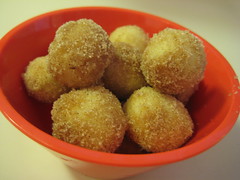Chocolate Chip Scones
 Print This Recipe
Print This Recipe
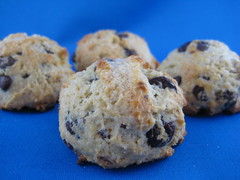 Last week I made these cupcakes for a friend’s bridal shower and had some buttermilk leftover. Before learning I could freeze buttermilk (who knew?), I made the buttermilk cake squares (yum!), then this scone recipe showed up in my Google Reader (thanks The Food Librarian!) and boom, leftover buttermilk be gone.
Last week I made these cupcakes for a friend’s bridal shower and had some buttermilk leftover. Before learning I could freeze buttermilk (who knew?), I made the buttermilk cake squares (yum!), then this scone recipe showed up in my Google Reader (thanks The Food Librarian!) and boom, leftover buttermilk be gone.
I followed the drop scone directions–scoop and bake–rather than shape into a circle and cut into wedges. The scooping was easy and the scones all came out around the same size. The end result was slightly crispy on the outside and soft and moist on the inside. They weren’t as dense as the scones I’m used to, but they were definitely delicious and super easy to make.
Photos of the process here.
Ingredients
2 cups unbleached all-purpose flour
1/3 cup sugar
1 teaspoon baking powder
1/2 teaspoon baking soda
1/2 teaspoon salt
6 tablespoons (3/4 stick) chilled unsalted butter, diced
1 teaspoon (packed) grated lemon peel (I omitted this)
3/4 cup miniature semisweet chocolate chips
3/4 cup chilled buttermilk
1 large egg yolk
1 teaspoon vanilla extract
Glaze: Milk and 2 T sugar
Preparation
- Preheat oven to 400 degrees.
- Line with Silpat or parchment two baking sheets.
- In a large bowl, mix together flour, sugar, baking powder, baking soda and salt.
- In a small mixing bowl or your measuring cup, blend together buttermilk, egg yolk and vanilla. Set aside.
- Cut up cold butter into small pieces and add to the flour mixture. (If you are adding the lemon zest, add here). Using your fingertips, rub in butter until the mixture is sandy or like rice grains. (Mine looked like sand, not rice grains.)
- Mix in the mini chocolate chips
- Pour buttermilk mixture over the flour mixture and mix until dough comes together. Do not overmix. Dough will be moist and soft.
- If you want to make triangle scones, gather the dough and press out on floured surface into an 8-inch round. Cut into 6 wedges.
- If you want to make drop scones, use a scooper to scoop dough onto lined baking sheets.
- Brush tops of scones with milk and sprinkle with sugar.
- Bake at 400 degrees for 18-20 minutes until golden brown. (Mine took around 15 minutes.)
I got about 20 scones using a small cookie scoop.
Recipe from Bon Appétit via The Food Librarian.
Baked Doughnuts
 Print This Recipe
Print This Recipe
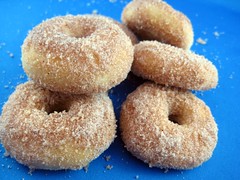 As I’ve mentioned before, I’ve never been a huge fan of doughnuts. Growing up, we ate bagels or cereal for breakfast, and doughnuts were thought of as a dessert. When I went away to college, doughnuts were available everywhere, and when I entered the working world, I noticed they were a regular early morning treat. I still never got into them, mainly because of the greasy feeling in my mouth and the heavy blah I would feel in my stomach after eating them.
As I’ve mentioned before, I’ve never been a huge fan of doughnuts. Growing up, we ate bagels or cereal for breakfast, and doughnuts were thought of as a dessert. When I went away to college, doughnuts were available everywhere, and when I entered the working world, I noticed they were a regular early morning treat. I still never got into them, mainly because of the greasy feeling in my mouth and the heavy blah I would feel in my stomach after eating them.
So when I had a random craving for doughnuts (I blame the Food Network), I Googled recipes for baked doughnuts and figured I’d give them a shot. Since I was trapped in my neighborhood this morning thanks to the LA Marathon, and the weather had finally cooled down enough to even think about turning on my oven, it seemed like the perfect day.
I halved the recipe, because I was afraid I would either a) not like them or b) like them, and didn’t want to have too many, either way. The process was fairly easy although time consuming, as are most yeast breads. The dough came together really nicely using the dough hook, and was easy to work with as well. Since I don’t have a doughnut cutter (oddly, there is such a thing), I used a 2-inch biscuit cutter, and the bottom of a pastry bag tip to cut out the inner circle. You can improvise–before I finally got around to buying a biscuit cutter, I used a drinking glass. Just look around your kitchen, you’ll find circular things.
Because I’m used to fried doughnuts, I was expecting these to be heavy, but was happily surprised to discover they were light and airy. The dips in butter and cinnamon-sugar finished the doughnuts off perfectly, and I can definitely see myself bringing these to a friend’s house–for brunch or dessert.
And don’t forget about the bonus doughnut holes. Enjoy!
Photos of the process here.
Ingredients
1 1/3 cups warm milk, 95 to 105 degrees (divided)
1 packet active dry yeast (2 1/4 teaspoons)
2 tablespoons butter
2/3 cup sugar
2 eggs
5 cups all-purpose flour
A pinch or two of nutmeg, freshly grated (I omitted this)
1 teaspoon fine grain sea salt
Cinnamon-Sugar Coating Ingredients
1/2 cup unsalted butter, melted
1 1/2 cups sugar
1 tablespoon cinnamon
Preparation
Place 1/3 cup of the warm milk in the bowl of an electric mixer. Stir in the yeast and set aside for five minutes. Be sure your milk isn’t too hot or it will kill the yeast. Stir the butter and sugar into the remaining cup of warm milk and add it to the yeast mixture. With a fork, stir in the eggs, flour, nutmeg, and salt – just until the flour is incorporated. With the dough hook attachment of your mixer beat the dough for a few minutes at medium speed. If your dough is overly sticky, add flour a few tablespoons at a time. If it’s too dry, add more milk a bit at a time. You want the dough to pull away from the sides of the mixing bowl and eventually become supple and smooth. Turn it out onto a floured counter-top, knead a few times (the dough should be barely sticky), and shape into a ball.
Transfer the dough to a buttered (or oiled) bowl, cover, put in a warm place, and let rise for an hour or until the dough has roughly doubled in size.
Punch down the dough and roll it out 1/2-inch thick on your floured countertop. If you don’t have a doughnut cutter, use a 2-3 inch cookie cutter to stamp out circles. Transfer the circles to a parchment-lined baking sheet and stamp out the smaller inner circles using a smaller cutter. If you cut the inner holes out any earlier, they become distorted when you attempt to move them. Cover with a clean cloth and let rise for another 45 minutes.
Bake in a 375 degree oven until the bottoms are just golden, 8 to 10 minutes–start checking around 8. While the doughnuts are baking, place the butter in a medium bowl. Place the sugar and cinnamon in a separate bowl.
Remove the doughnuts from the oven and let cool for just a minute or two. Dip each one in the melted butter and toss in the sugar bowl.
Makes 1 1/2 – 2 dozen medium doughnuts. (And just as many doughnut holes!)
Recipe from 101 Cookbooks.
Bagels
 Print This Recipe
Print This Recipe
Growing up, bagels or (non-sugared) cereal were what we ate for breakfast regularly. On weekends my mom would make us these baked pancakes with apples and cinnamon, but most of the time it was bagels.
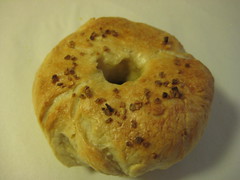 In fact, until I went away to college I had never even tasted a Pop Tart or eaten a doughnut for breakfast, and to this day, doughnuts for breakfast are just odd to me. I’ve been told this is a Jewish thing.
In fact, until I went away to college I had never even tasted a Pop Tart or eaten a doughnut for breakfast, and to this day, doughnuts for breakfast are just odd to me. I’ve been told this is a Jewish thing.
Back to the bagel. There are two kinds of bagels: good bagels and bad bagels. Good bagels have a tough exterior and are chewy on the inside. Bad bagels have a soft exterior and are bready on the inside. Seriously, it’s that simple.
My family would usually buy a dozen bagels at a time, and we’d eat them throughout the week, in various ways. For breakfast you can eat them with a schmear (and lox), with jelly, with melted cheese, you name it. At lunch time, you can use a bagel in place of loaf bread in a sandwich. And for dinner–the pizza bagel (my sister and I loved these)! See, bagels are a multi-purpose food. And you can freeze them too. Which is what I did with some of these.
And surprisingly, they weren’t that difficult to make. As with most breads, there was a lot of waiting time, but other than that, the recipe was pretty simple. Unfortunately, mine are ugly and probably could have used more time to initially rise, but I was impatient and my apartment was getting warm (this is when I mention it was 75 degrees here yesterday, don’t hate me.)
Sponge Ingredients
1 teaspoon instant yeast
4 cups unbleached high-gluten or bread flour (I used bread flour)
2 1/2 cups water, room temperature
Dough Ingredients
1/2 teaspoon instant yeast
3 3/4 cups unbleached high-gluten or bread flour (I used bread flour)
2 3/4 teaspoons salt
2 teaspoons malt powder or 1 tablespoon dark or light malt syrup, honey, or brown sugar (I used brown sugar)
To Finish
1 tablespoon baking soda
Cornmeal or semolina flour for dusting
Sesame seeds, poppy seeds, kosher salt, rehydrated dried minced garlic or onions, or chopped onions that have been tossed in oil (optional)
Day one
- To make the sponge, stir the yeast into the flour in a 4-quart mixing bowl. Add the water, whisking or stirring only until it forms a smooth, sticky batter. Cover the bowl with plastic wrap and leave at room temperature for approximately 2 hours, or until the mixture becomes very foamy and bubbly. It should swell to nearly double in size and collapse when the bowl is tapped on the countertop.
- To make the dough, in the same mixing bowl (or in the bowl of an electric mixer), add the additional yeast to the sponge and stir. Then add 3 cups of the flour and all of the salt and malt (I used brown sugar.). Stir (or mix on low speed with the dough hook) until the ingredients form a ball, slowly working in the remaining 3/4 cup flour to stiffen the dough.
- Transfer the dough to the counter and knead for at least 10 minutes (or for 6 minutes by machine). The dough should be firm, stiffer than French bread dough, but still pliable and smooth. There should be no raw flour – all ingredients should be hydrated. The dough should pass the windowpane test and register 77 to 71 degrees F. If the dough seems to dry and rips, add a few drops of water and continue kneading. If the dough seems tacky or sticky, add more flour to achieve the stiffness required. The kneaded dough should feel satiny and pliable but not be tacky.
- Immediately divide the dough into 4 1/2 ounce pieces for standard bagels, or smaller if desired. Form the pieces into rolls.
- Cover the rolls with a damp towel and allow them to rest for approximately 20 minutes.
- Line 2 sheet pans with baking parchment and mist lightly with spray oil. Proceed with one of the following shaping methods:
- Method 1: Poke a hole in a ball of bagel dough and gently rotate your thumb around the inside of the hole to widen it to approximately 2 1/2 inches in diameter (half of this for a mini-bagel). The dough should be as evenly stretched as possible (try to avoid thick and thin spots.)
- Method 2: Roll out the dough into an 8-inch long rope. (This may require rolling part of the way and resting if the pieces are too elastic and snap back, in which case, allow them to rest for 3 minutes and then extend them again to bring to full length. Wrap the dough around the palm and back of your hand, between the thumb and forefinger, overlapping the ends by several inches. Press the overlapping ends on the counter with the palm of your hand, rocking back and forth to seal.
- Place each of the shaped pieces 2 inches apart on the pans. Mist the bagels very lightly with the spray oil and slip each pan into a food-grade plastic bag, or cover loosely with plastic wrap. Let the pans sit at room temperature for about 20 minutes.
- Check to see if the bagels are ready to be retarded in the refrigerator by using the “float test.” Fill a small bowl with cool or room-temperature water. The bagels are ready to be retarded when they float within 10 seconds of being dropped into the water. Take one bagel and test it. If it floats, immediately return the tester bagel to the pan, pat it dry, cover the pan, and place it in the refrigerator overnight (it can stay in the refrigerator for up to 2 days). If the bagel does not float. Return it to the pan and continue to proof the dough at room temperature, checking back every 10 to 20 minutes or so until a tester floats. The time needed to accomplish the float will vary, depending on the ambient temperature and the stiffness of the dough.
The Following Day
- Preheat the oven to 500 degrees F with the two racks set in the middle of the oven. Bring a large pot of water to a boil (the wider the pot the better), and add the baking soda. Have a slotted spoon or skimmer nearby.
- Remove the bagels from the refrigerator and gently drop them into the water, boiling only as many as comfortably fit (they should float within 10 seconds). After 1 minute flip them over and boil for another minute. If you like very chewy bagels, you can extend the boiling to 2 minutes per side. While the bagels are boiling, sprinkle the same parchment-lined sheet pans with cornmeal or semolina flour. (If you decide to replace the paper, be sure to spray the new paper lightly with spray oil to prevent the bagels from sticking to the surface.) If you want to top the bagels, do so as soon as they come out of the water. You can use any of the suggestions in the ingredients list or a combination.
- When all the bagels have been boiled, place the pans on the 2 middle shelves in the oven. Bake for approximately 5 minutes, then rotate the pans, switching shelves and giving the pans a 180-degree rotation. (If you are baking only 1 pan, keep it on the center shelf but still rotate 180 degrees.) After the rotation, lower the oven setting to 450 degrees F and continue baking for about 5 minutes, or until the bagels turn light golden brown. You may bake them darker if you prefer.
- Remove the pans from the oven and let the bagels cool on a rack for 15 minutes or longer before serving.
Recipe from Peter Reinhart via Smitten Kitchen.
Sticky Buns
 Print This Recipe
Print This Recipe
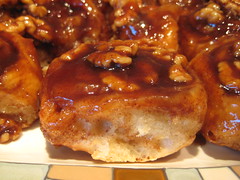 My first ever job was working at a Mrs. Fields bakery called La Petite Boulangerie while I was in high school. During the summer and on weekends, I would arrive at the bakery at 6:30 in the morning (can you believe they trusted a 16-year-old with keys to the place?) and along with the baker, prepare all the muffins, cookies, and breads for sale. The last thing out of the oven was always the cinnamon rolls and sticky buns, and the smell of cinnamon would permeate the bakery for hours.
My first ever job was working at a Mrs. Fields bakery called La Petite Boulangerie while I was in high school. During the summer and on weekends, I would arrive at the bakery at 6:30 in the morning (can you believe they trusted a 16-year-old with keys to the place?) and along with the baker, prepare all the muffins, cookies, and breads for sale. The last thing out of the oven was always the cinnamon rolls and sticky buns, and the smell of cinnamon would permeate the bakery for hours.
On the rare occasion we didn’t sell out of these goodies, I’d bring them home to my family and we’d microwave them before gobbling them up. And every so often, I’d put one aside in the morning and my dad would stop by the bakery for a sticky bun fresh out of the oven. They quickly became one of his favorite treats. So, when I found this recipe I bookmarked it and knew I had to bake them the next time I was at my parents’ house, and I’m so glad I did. The buns are soft and flavorful, and the sticky sauce is the perfect combination of maple and cinnamon. In fact, you may even be tempted to eat it by the spoonful.
Photos of the long yet not difficult process here.
Dough Ingredients
1 large egg yolk
1 c. whole milk (I used lowfat)
1 tsp. pure vanilla extract
Zest of 1 orange (I omitted this)
2 1/2 to 2 3/4 c. all-purpose flour
2 Tbsp. unsalted butter, softened
2 1/4 tsp. (1 package) active dry yeast
1 1/2 tsp. kosher salt
1/4 c. sugar
Sticky Sauce Ingredients
1/2 lb. (2 sticks) unsalted butter
3/4 c. firmly packed light brown sugar
1/2 c. pure maple syrup
1 1/2 tsp. ground cinnamon
Egg Wash
1 large egg
2 Tbsp. whole milk or heavy cream (I used low fat milk)
Cinnamon Sugar
1 Tbsp. plus 1 1/2 tsp. freshly ground cinnamon
1/2 c. sugar
Finishing
1 c. whole natural almonds, lightly toasted and coarsely chopped (I used walnuts and put them in the pan with the sticky sauce at the beginning)
First Rise
- In the bowl of an electric mixer fitted with the whip attachment, combine the egg yolk, milk, vanilla, zest, and one-third of the flour. Mix on medium speed until it is a smooth paste. Add the butter in pieces and mix to combine.
- Change the mixer attachment to a dough hook. Add the remaining flour, the yeast, salt, and sugar and mix on low speed to combine. Increase the speed to medium and beat for 10 to 15 minutes, or until the dough forms a ball and is no longer sticking to the sides of the bowl. The dough should be nice and elastic. If it is very sticky, slowly add up to 1/2 cup more flour. (I used the additional 1/2 cup.)
- Place the dough in a lightly greased bowl and cover with plastic wrap. Set aside in a warm place to rise until doubled in volume, 1 1/2 to 2 hours.
Sticky Sauce Preparation
- Generously butter a 9×13 inch baking pan.
- In a medium saucepan, combine the butter, brown sugar, maple syrup, and cinnamon, stirring until it reaches a rolling boil.
- Remove from heat and pour into the prepared pan. Set aside to cool.
Second Rise
- When the dough has doubled in volume, punch it down and turn it out onto a lightly floured work surface. Roll out the dough into a rectangle that is 12 inches wide by 18 inches long.
- For the egg wash: In a small bowl, using a fork, whisk together the egg and milk. Using a pastry brush, brush it over the surface of the dough.
- For the cinnamon sugar: In a small bowl, combine the cinnamon and sugar. Sprinkle over the dough, leaving unsugared the bottom 1 inch of one long side of the rectangle.
- Starting at the top edge of the rectangle, roll the dough toward you jelly-roll style and pinch the bottom seam closed. Slice the roll into 12 pieces approximately 1 1/2 inches thick, and place them cut side up about 2 inches apart on top of the sticky sauce in the pan. Spray the buns lightly with nonstick vegetable cooking spray and cover with plastic wrap (or lighly butter one side of the plastic wrap). Refrigerate overnight.
Complete the Buns
- When you are ready for the final rise, remove the buns from the refrigerator. Bring about 3 quarts of water to a boil. Place an empty roasting pan large enough to hold the water on the bottom of your cold oven. Pour the boiling water into the pan.
- Remove the plastic wrap from the buns. Position a rack in the center of your oven. Place the pan on the rack in the oven (do not turn it on!) and shut the door. The steam of the water will help the buns in their final rise. The buns will just about double in size in 30 to 45 minutes. (If your fridge is on a super-cold setting, the buns may need a little longer to rise. If they need more time, just boil some more water and refill the roasting pan.) When the buns have doubled in volume, remove them (and the roasting pan filled with water) from the oven.
- Preheat the oven to 350 degrees.
- Bake for 20 to 25 minutes, or until golden brown. Remove to a wire rack to cool for about 10 minutes. Using tongs, turn the buns over onto a serving dish. Pour the sticky sauce in the pan over the buns and sprinkle with the chopped almonds.
Recipe adapted from Not Microwave Safe.
Napoletana Pizza
 Print This Recipe
Print This Recipe
 I love pizza. Thin crust, thick crust, deep dish, whatever. I love it all. This is my second attempt at pizza dough (the first time I made this yummy recipe) and I’m still amazed at how easy it is.
I love pizza. Thin crust, thick crust, deep dish, whatever. I love it all. This is my second attempt at pizza dough (the first time I made this yummy recipe) and I’m still amazed at how easy it is.
Although this recipe looks daunting with the multiple steps, don’t be scared! It’s fairly simple to make, worth the time, and yields a thin crust with a nice crunch is spots. Top it with whatever you want (I used homegrown green peppers from my balcony garden, among other things), and enjoy your delicious pizza!
Photos of the process here.
Some notes:
- I used a mixer (first the paddle attachment then the dough hook) and froze all of the dough balls so that I can pull them out and put them in the fridge the night before I want to make pizza. Talk about convenient!
- I don’t have a pizza stone so I used a regular cookie sheet and baked the pizza at 450F for 7-8 minutes.
- I had trouble tossing the dough so I rolled it out with a rolling pin.
Ingredients
4 1/2 c unbleached high-gluten, bread, or all-purpose flour, chilled (I used bread flour)
1 3/4 tsp salt
1 tsp instant yeast
1/4 c olive oil
1 3/4 c water, ice cold (40°F)
Semolina flour or cornmeal for dusting (I used cornmeal)
Preparation, Day One
- Using an electric mixer fitted with the paddle attachment, stir together the flour, salt, and instant yeast in a 4-quart bowl. On low speed, stir in the oil and the cold water until the flour is all absorbed. Switch to the dough hook and mix on medium speed for 5 to 7 minutes, or as long as it takes to create a smooth, sticky dough. The dough should clear the sides of the bowl but stick to the bottom of the bowl. If the dough is too wet and doesn’t come off the sides of the bowl, sprinkle in some more flour just until it clears the sides. If it clears the bottom of the bowl, dribble in a teaspoon or two of cold water. The finished dough will be springy, elastic, and sticky, not just tacky, and register 50 to 55F.
- Sprinkle flour on the counter and transfer the dough to the counter. Prepare a sheet pan by lining it with baking parchment and misting the parchment with spray oil (or lightly oil the parchment). Using a metal dough scraper, cut the dough into 6 equal pieces (or larger if you are comfortable shaping large pizzas), You can dip the scraper into the water between cuts to keep the dough from sticking to it. Sprinkle flour over the dough. Make sure your hands are dry and then flour them. Lift each piece and gently round it into a ball. If the dough sticks to your hands, dip your hands into the flour again. Transfer the dough balls to the sheet pan. Mist the dough generously with spray oil and slip the pan into a food-grade plastic bag.
- Put the pan into the refrigerator overnight to rest the dough, or keep for up to 3 days. (Note: If you want to save some of the dough for future baking, you can store the dough balls in a zippered freezer bag. Dip each dough ball into a bowl that has a few tablespoons of oil in it, rolling the dough in the oil, and then put each ball into a separate bag. You can place the bags into the freezer for up to 3 months. Transfer them to the refrigerator the day before you plan to make pizza.)
Preparation, Day Two
- On the day you plan to make the pizza, remove the desired number of dough balls from the refrigerator two hours before making the pizza. Dust the counter with flour, and then mist the counter with spray oil. Place the dough balls on top of the floured counter and sprinkle them with flour; dust your hands with flour. Gently press the dough into flat disks about 1/2 inch thick and 5 inches in diameter. Sprinkle the dough with flour, mist it again with spray oil, and cover the dough loosely with plastic wrap or a food-grade plastic bag. Let rest for 2 hours.
- At least 45 minutes before making the pizza, place a baking stone either on the floor of the oven (for gas ovens), or on a rack in the lower third of the oven. Preheat the oven as hot as possible, up to 800F (most home ovens will go only to 500 to 550F, but some will go higher). If you do not have a baking stone, you can use the back of a sheet pan, but do not preheat the pan.
- Generously dust a peel or the back of a sheet pan with semolina flour or cornmeal. Make the pizzas one at a time. Dip your hands, including the backs of your hands and knuckles, in flour and lift I piece of dough by getting under it with a pastry scraper. Very gently lay the dough across your fists and carefully stretch it by bouncing the dough in a circular motion on your hands, carefully giving it a little stretch with each bounce. If it begins to stick to your hands, lay it down on the floured counter and reflour your hands, then continue shaping it. Once the dough has expanded outward, move to a full toss. If you have trouble tossing the dough, or if the dough keeps springing back, let it rest for 5 to 20 minutes so the gluten can relax, and try again. You can also resort to using a rolling pin, though this isn’t as effective as the toss method.
- When the dough is stretched out to your satisfaction (about 9 to 12 inches in diameter for a 6-ounce piece of dough), lay it on the peel or pan, making sure there is enough semolina flour or cornmeal to allow it to slide. Lightly top it with sauce and then with your other toppings, remembering that the best pizzas are topped with a less-is-more philosophy. The American “kitchen sink” approach is counterproductive, as it makes the crust more difficult to bake. A few, usually no more than 3 or 4 toppings, including sauce and cheese is sufficient.
- Slide the topped pizza onto the stone (or bake directly on the sheet pan) and close the door. Wait 2 minutes, then take a peek. If it needs to be rotated 180 degrees for even baking, do so. The pizza should take about 5 to 8 minutes to bake. If the top gets done before the bottom, you will need to move the stone to a lower self before the next round. if the bottom crisps before the cheese caramelizes, then you will need to raise the stone for subsequent bakes.
- Remove the pizza from the oven and transfer to a cutting board. Wait 3 to 5 minutes before slicing and serving, to allow the cheese to set slightly.
Makes six 6-ounce pizza crusts.
Adapted from The Bread Baker’s Apprentice via Perry’s Plate.
– – –
Also, just a reminder that Nosh is participating in the Donor’s Choose social media challenge. Please donate!
